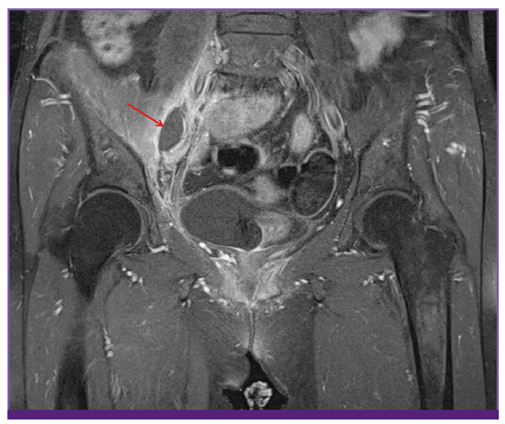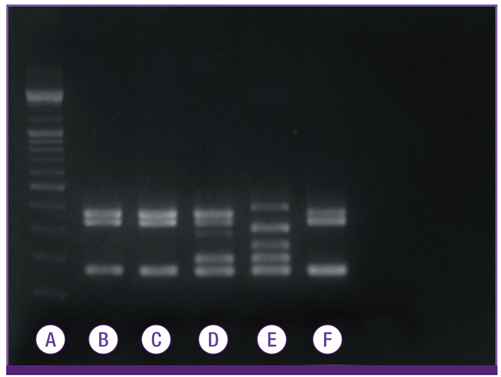Infect Chemother.
2013 Dec;45(4):441-445. 10.3947/ic.2013.45.4.441.
A Case of Acute Pyogenic Sacroiliitis and Bacteremia Caused by Community-Acquired Methicillin-Resistant Staphylococcus aureus
- Affiliations
-
- 1Department of Internal Medicine, Gachon University Gil Medical Center, Incheon, Korea.
- 2Division of Infectious Disease, Gachon University Gil Medical Center, Incheon, Korea. karmacho@gmail.com
- KMID: 2170449
- DOI: http://doi.org/10.3947/ic.2013.45.4.441
Abstract
- Pyogenic sacroiliitis is a rare osteoarticular infection, occurring most frequently in children and young adults. Diagnosis of the disease is challenging because of a general lack of awareness of the disease and its nonspecific signs and symptoms. Staphylococcus aureus is the most common causative bacteria in pyogenic sacroiliitis. Methicillin-resistant S. aureus (MRSA) has typically been considered a hospital-associated pathogen; however, community-acquired (CA)-MRSA infections are becoming increasingly common in Korea. We report the first domestic case of acute pyogenic sacroiliitis with abscess and bacteremia caused by CA-MRSA. The pathogen carried the type IV-A staphylococcal cassette chromosome mec (SCCmec) without the Panton-Valentine leukocidin (PVL) gene, and was identified as sequence type (ST) 72 by multilocus sequence typing.
Keyword
MeSH Terms
Figure
Reference
-
1. Hodgson BF. Pyogenic sacroiliac joint infection. Clin Orthop Relat Res. 1989; 146–149.
Article2. Doita M, Yoshiya S, Nabeshima Y, Tanase Y, Nishida K, Miyamoto H, Watanabe Y, Kurosaka M. Acute pyogenic sacroiliitis without predisposing conditions. Spine (Phila Pa 1976). 2003; 28:E384–E389.
Article3. Taylor ZW, Ryan DD, Ross LA. Increased incidence of sacroiliac joint infection at a children's hospital. J Pediatr Orthop. 2010; 30:893–898.
Article4. Wu MS, Chang SS, Lee SH, Lee CC. Pyogenic sacroiliitis--a comparison between paediatric and adult patients. Rheumatology (Oxford). 2007; 46:1684–1687.
Article5. Molinos Quintana A, Morillo Gutiérrez B, Camacho Lovillo MS, Neth O, Obando Santaella I. Pyogenic sacroiliitis in children-a diagnostic challenge. Clin Rheumatol. 2011; 30:107–113.
Article6. Liu C, Bayer A, Cosgrove SE, Daum RS, Fridkin SK, Gorwitz RJ, Kaplan SL, Karchmer AW, Levine DP, Murray BE, J Rybak M, Talan DA, Chambers HF. Infectious Diseases Society of America. Clinical practice guidelines by the infectious diseases society of america for the treatment of methicillin-resistant Staphylococcus aureus infections in adults and children. Clin Infect Dis. 2011; 52:e18–e55.7. Hermet M, Minichiello E, Flipo RM, Dubost JJ, Allanore Y, Ziza JM, Gaudin P, Thomas T, Dernis E, Glace B, Regnier A, Soubrier M. Infectious sacroiliitis: a retrospective, multicentre study of 39 adults. BMC Infect Dis. 2012; 12:305.
Article8. Oliveira DC, de Lencastre H. Multiplex PCR strategy for rapid identification of structural types and variants of the mec element in methicillin-resistant Staphylococcus aureus. Antimicrob Agents Chemother. 2002; 46:2155–2161.
Article9. Enright MC, Day NP, Davies CE, Peacock SJ, Spratt BG. Multilocus sequence typing for characterization of methicillin-resistant and methicillin-susceptible clones of Staphylococcus aureus. J Clin Microbiol. 2000; 38:1008–1015.
Article10. Song JS, Choe PG, Song KH, Cho JH, Kim SH, Bang JH, Lee CS, Park KH, Park KU, Shin S, Choi HJ, Kim ES, Kim DM, Lee MS, Park WB, Kim NJ, Oh MD, Kim EC, Kim HB, Choe KW. Multicenter study for frequency and clinical features of community-associated methicillin-resistant Staphylococcus aureus in Korea. Infect Chemother. 2006; 38:325–333.11. Schaad UB, McCracken GH Jr, Nelson JD. Pyogenic arthritis of the sacroiliac joint in pediatric patients. Pediatrics. 1980; 66:375–379.
Article12. Ford LS, Ellis AM, Allen HW, Campbell DE. Osteomyelitis and pyogenic sacroiliitis: A difficult diagnosis. J Paediatr Child Health. 2004; 40:317–319.
Article13. Attarian DE. Septic sacroiliitis: the overlooked diagnosis. J South Orthop Assoc. 2001; 10:57–60.14. Klein MA, Winalski CS, Wax MR, Piwnica-Worms DR. MR imaging of septic sacroiliitis. J Comput Assist Tomogr. 1991; 15:126–132.
Article15. Moran GJ, Krishnadasan A, Gorwitz RJ, Fosheim GE, McDougal LK, Carey RB, Talan DA. EMERGEncy ID Net Study Group. Methicillin-resistant S. aureus infections among patients in the emergency department. N Engl J Med. 2006; 355:666–674.
Article16. Fish DN, Chow AT. The clinical pharmacokinetics of levofloxacin. Clin Pharmacokinet. 1997; 32:101–119.
Article17. Haanpää M, Hannonen P, Kaira P, Laurikainen J, Möttönen TT, Oka M. Clinical sequelae and sacroiliac joint changes by computed tomography after recovery from septic sacroiliitis. Clin Rheumatol. 1989; 8:197–201.
Article18. Kim ES, Song JS, Lee HJ, Choe PG, Park KH, Cho JH, Park WB, Kim SH, Bang JH, Kim DM, Park KU, Shin S, Lee MS, Choi HJ, Kim NJ, Kim EC, Oh MD, Kim HB, Choe KW. A survey of community-associated methicillin-resistant Staphylococcus aureus in Korea. J Antimicrob Chemother. 2007; 60:1108–1114.
Article
- Full Text Links
- Actions
-
Cited
- CITED
-
- Close
- Share
- Similar articles
-
- Community-acquired Methicillin-resistant Staphylococcus aureus Bacteremia Complicated by Acute Cholecystitis
- Clinical Observation on Staphylococcus aureus Bacteremia of Community Hospital
- Erratum: A Case of Acute Pyogenic Sacroiliitis and Bacteremia Caused by Community-Acquired Methicillin-Resistant Staphylococcus aureus
- Erratum: A Case of Acute Pyogenic Sacroiliitis and Bacteremia Caused by Community-Acquired Methicillin-Resistant Staphylococcus aureus
- A case of multiple furunculosis caused by methicillin-resistant staphylococcs aureus



